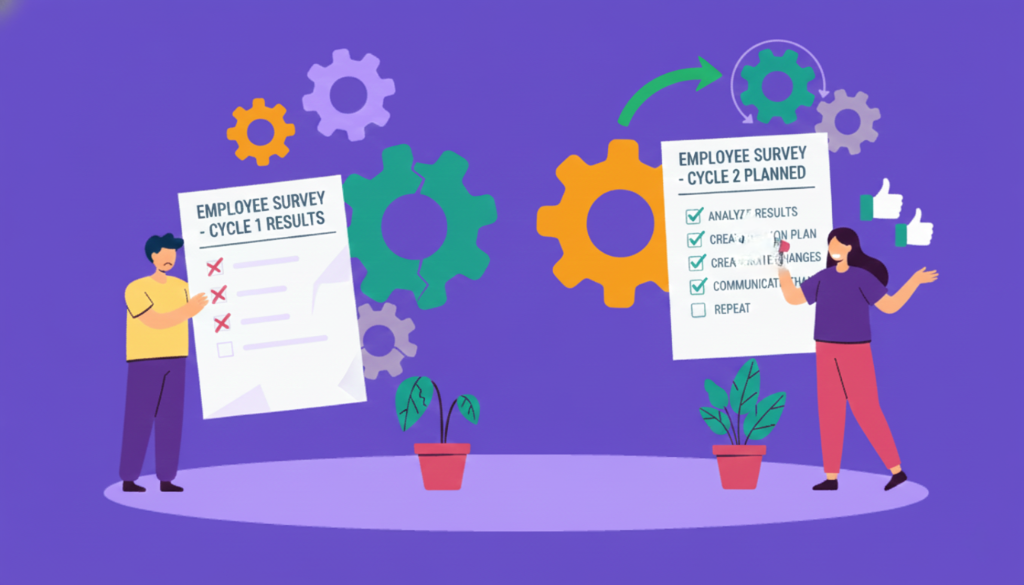Employee Benefits Surveys: Sample Questions to Enhance Your Benefits Strategy

A Global Employee Recognition and Wellness Platform
Times have changed. In today’s job market, salaries alone don’t cut it anymore. Employees aren’t just looking for a paycheck; they want to feel valued, supported, and taken care of, and that extends far beyond their base salary.
You might think you’ve got your employee benefits package down, after all, you offer health insurance, retirement plans, and some PTO. But here’s the thing: are those benefits really hitting the mark for your people? Do they even know what benefits are available to them? Are they using them? More importantly, are they actually getting what they need from them?
A 2025 report highlights that employees are ignoring or underusing up to $3 trillion in available benefits annually in the U.S, can you afford to keep guessing? It’s time to stop leaving money on the table and start listening to what your employees want from their benefits.
What are Employee Benefits Surveys?

Employee benefits surveys are a set of targeted questionnaire about understanding what employees value most, how they use the benefits offered, and most importantly, whether your current benefits package is the right fit for your employees.
The challenge is that employees aren’t all the same. They come from different life stages, job roles, and work environments, which means they have different needs and preferences. No single benefits package can cater to everyone.
Remote workers, for example, might value things like home office stipends or mental health support. In contrast, in-office employees may prefer commuter benefits or an on-site gym.
Younger employees, often in their 20s, might be more interested in student loan repayment programs or opportunities for career development. Mid-career employees, especially those with families, are likely to appreciate benefits like childcare support or flexible paid time off.
Each group has different needs, and it’s important to recognize those differences when crafting a benefits package. An employee benefits survey is the perfect tool to understand these diverse preferences and ensure your offerings align with what your team truly values. They help you find the right balance. The goal is to offer a package that suits not only your current workforce but also helps you attract the future talent you want to bring in.
So, how do you get better insights? It's all about asking the right questions. Questions that force employees to think beyond a simple “yes” or “no” answer, and that help you uncover the why behind their opinions. Instead of asking, “Are you happy with your healthcare plan?” consider:
“Do you fully understand the details of your health insurance plan?”
“Have you used the health plan in the last 6 months?”
“Would you prefer better healthcare coverage over more vacation days?”
By understanding how and why employees interact with their benefits, you’ll be better equipped to tailor your offerings and make them more relevant.
What is the Purpose of Employee Benefits Surveys?
You’re probably thinking, “Our benefits are fine. We’ve got health insurance, retirement plans, and PTO. What else do we need to ask?”
Yes, companies offer all these benefits, but here’s the real question: Are these benefits actually for the employees, or are they just there to check a box on the employer’s to-do list?
What's the point of offering health insurance if it doesn’t cover the things employees actually need? What good is PTO if, when you finally take it, you get the angry eyes from your manager or feel guilty for using it?
Employee benefits surveys help you move beyond assumptions. They give you real insights into what your employees actually value, so you can tailor your benefits accordingly.
Here are some reasons why benefits surveys are important:
1. They Help You Identify Misaligned Assumptions
You think your employees love their health insurance, but how do you know? Perhaps they value more comprehensive mental health coverage instead. One-size-fits-all benefits often lead to overspending on perks employees don’t use, while neglecting the ones they really care about. A benefits survey breaks down these assumptions and helps you target the gaps in your offering with clear, actionable insights.
Example: According to SureCo’s 2024 State of Employee Health Benefits Report, 47% of employees have considered seeking alternative health insurance outside their employer’s offerings, indicating dissatisfaction or unmet needs. But are you aware of that disconnect? Only a survey can reveal the gap between what you think employees want and what they actually value.
2. They Expose Deeper Organizational Issues
Employee benefits surveys don’t just reveal what employees want, they highlight underlying issues within the organization. For example, if employees are asking for more mental health days, it’s a sign they’re feeling mentally drained. This could point to a workplace culture issue, such as excessive workload or insufficient support, and should prompt a closer look at your company’s structure.
Similarly, requests for more PTO can indicate employees feel undervalued or unrecognized. This isn’t just about more time off, it reflects deeper engagement and retention challenges.
By identifying these patterns, benefits surveys help companies introspect and address potential problems before they escalate, ensuring benefits are not just perks but signals for improving workplace health.
3. They Act as a Key Recruitment Driver
An employee benefits survey helps you understand what today’s top talent is looking for. Whether it’s flexible work arrangements, financial wellness programs, or something else knowing what resonates with potential hires gives you the competitive edge you need to attract the best candidates. McKinsey even notes that benefits are "as important as salary-if not more" for many Americans
By aligning your benefits with what jobseekers value most, your company becomes more attractive and increases its chances of securing the talent that will drive its success.
4. They Help Ensure Budget Allocation Makes Sense
Allocating the same budget to things like monthly snack vouchers and mental wellness days doesn’t make sense if one is used extensively while the other goes completely unnoticed. Benefits budgets are often spread too thin across perks that don’t add value, meaning companies could be pouring money into perks, employees don’t even care about, while more impactful benefits remain underfunded.
An employee benefits survey helps identify which benefits truly matter to your workforce, allowing you to reallocate resources more effectively. By understanding what your employees need most, you can ensure that your benefits budget is spent on the right perks, the ones that drive engagement, boost morale, and ultimately enhance retention.
What type of Questions should you Include?

Employee benefits surveys are only effective when they’re well-structured and target the right areas. To ensure that HR teams gather actionable insights, it’s important to categorize benefits and tailor questions to measure employee satisfaction, usage, and employee preferences.
Here’s a strong blueprint of what your benefits survey should cover:
1. Health & Wellness
67% of U.S. employees say healthcare benefits are the most important, which clearly shows the critical role health and wellness play in their overall benefits package. It's not just about affordability, it’s about whether employees feel supported and how easily they can access care. Questions should explore both satisfaction and usage to ensure your benefits align with employee needs.
Sample Questions:
“Are you aware that our current health insurance plan includes dental and vision care?”
(Yes/No)
“How comprehensive do you feel our health insurance plan is in covering both preventive and emergency care?”
(Rating scale: Very comprehensive, Somewhat comprehensive, Not comprehensive)
“What is the most difficult aspect of using our current health insurance plan?”
(Open-ended)
“Would you prefer more options to customize your healthcare coverage, such as adding specific benefits or increasing coverage in certain areas?”
(Yes/No)
2. Retirement Plans
Retirement benefits are a critical long-term concern for employees, and understanding whether they align with employees' financial goals is essential. This area also helps you understand if employees feel secure about their future with the benefits offered.
Sample Questions:
“Does the 401(k) match align with your retirement goals?” (Rating scale)
“Have you ever sought financial planning advice through your retirement benefits?” (Yes/No)
3. PTO and Leave Policies
Paid time off is often seen as a reflection of how much employees are valued. Understanding how comfortable employees are requesting leave or whether they’re using their PTO can reveal a lot about your company’s work culture.
Sample Questions:
“How comfortable are you requesting sick leave?” (Rating scale)
“Do you feel our PTO policy supports your work-life balance?” (Yes/No)
4. Career Development Support
Employees want to grow in their careers, and the professional development opportunities you offer can be a significant driver of engagement and retention. Survey questions should assess how employees are utilizing and valuing these benefits.
Sample Questions:
“Have you used your tuition reimbursement in the past year?” (Yes/No)
“Do you feel your career development opportunities align with your personal growth goals?” (Rating scale)
5. Family Support Benefits
Support for employees' families, whether through childcare assistance, paid parental leave, or elder care support, can be a huge factor in retention, particularly for employees with families. Understanding the level of importance employees place on these benefits helps fine-tune offerings.
Sample Questions:
“Is childcare support important to you?” (Yes/No)
“Do you feel the company’s family leave policies meet your needs?” (Rating scale)
6. Flexibility & Work-Life Balance
Flexibility in the workplace is no longer a luxury, it’s expected. The ability to work remotely or have flexible hours can greatly impact employee satisfaction. Understanding how employees feel about the company’s flexibility policies is crucial to attracting and retaining talent.
Sample Questions:
“Would you trade additional PTO for more remote work days?” (Yes/No)
“How satisfied are you with the level of flexibility in your work schedule?” (Rating scale)
7. Additional Perks
From wellness stipends to commuter benefits, employees often value small perks that add convenience and quality of life to their day-to-day routine. These can seem like smaller items, but they often make a big impact on employee satisfaction.
Sample Questions:
“Which perks (wellness stipend, commuter benefits) do you value most?” (Open-ended)
“Do you use the wellness stipend, and if so, what do you spend it on?” (Usage question)
What's the Right Way to Design an Employee Benefits Survey?
1. Start with one crystal-clear goal

Before you write a single question, decide what you’re trying to solve. Are you realigning benefits to new employee needs? Auditing actual usage? Measuring how well your package supports DEI commitments? Pick one north star; everything else flows from it.
2. Ask only what you can act on
Nothing erodes trust faster than questions you have no intention, or budget to address. If offering gym memberships is not an option this year, don’t ask employees if they would prefer it over other perks. Limit the survey to benefits you can realistically tweak or enhance within the upcoming cycle.
3. Guarantee anonymity and say it up front
Open the survey with a plain-english promise: “All responses are aggregated; no individual answers will ever be shared.” Use an anonymous tool like Vantage Pulse, Culture Amp or Qualtrics, and skip identifying data beyond what’s essential for later analysis. When people feel safe, candor skyrockets.
4. Cover the big pillars, not every fringe perk
Keep the questionnaire lean by focusing on six benefit families that matter to almost everyone:
Health insurance (including mental-health coverage)
Retirement and financial wellness
Paid time off (vacation, sick, parental)
Wellness programs (gym, nutrition, coaching)
Flexible or hybrid work support
DEI-oriented benefits (family-building, elder care, affinity resources)
For each pillar, mix three question types:
Usage – “How often have you tapped our mental-health sessions this year?”
Importance – “How important is customizable WFH equipment to you?”
Trade-off – “If budget allowed only one, would you choose three extra PTO days or a higher HSA match?”
5. Slice the data after—not during—the survey

Collect only minimal demographics (age band, parent status, remote vs. office, career level). Once the responses are in, segment them: younger staff may crave skill-building stipends; parents may lobby for stronger childcare support; executives could push for supplemental retirement matches. You’ll spot patterns without forcing employees through endless branching questions.
6. Get the cadence right
Run a full survey once a year, twice if you’re growing fast or fresh off a merger. Between
cycles, send micro-pulses (three or four questions) after launching a new benefit to check uptake and sentiment while it’s fresh.
7. Close the loop, fast
Within 30 days, publish a one-pager titled “What We Heard / What We’ll Do.” Flag quick wins (clearer PTO rules) and longer projects (budget shifts). When employees see action, your next survey’s response rate climbs, and the insights get richer.
How Vantage Pulse Can Help
Vantage Pulse makes it easy to collect and analyze employee feedback, turning insights into action. With customizable surveys, you can track trends over time, segment responses by demographics, and pinpoint areas for improvement in your benefits offerings.
It not only simplifies the process of gathering data but provides actionable reports that help you make informed decisions to enhance employee satisfaction and retention. Ready to optimize your benefits strategy? Let Vantage Pulse help you turn feedback into real impact.
Conclusion
Employee benefits surveys are more than just a formality, they’re a strategic tool that can transform how you approach employee satisfaction and retention. They offer you the chance to move beyond assumptions and gather real feedback that helps you tailor your benefits package to meet the evolving needs of your team. By listening to employees and acting on their insights, you not only boost engagement but create a more supportive, attractive workplace.
FAQs:
Q.1 What are the most important benefits for employees?
The most important benefits often include healthcare, retirement plans, PTO, and work-life balance perks, with increasing demand for mental health support and flexibility.
Q.2 What are the top 'green benefits' that employees are currently seeking?
Employees are increasingly interested in sustainable benefits like commuter subsidies, environmental wellness programs, and corporate sustainability initiatives.
Q.3 What are some examples of innovative benefits that other companies are offering?
Innovative benefits include student loan repayment assistance, fertility support, financial wellness programs, and mental health days to address evolving employee needs.
Q.4 How often should we conduct employee benefits surveys to ensure accurate feedback?
It’s ideal to conduct surveys annually or bi-annually, with pulse surveys in between to capture timely shifts in employee priorities.



















